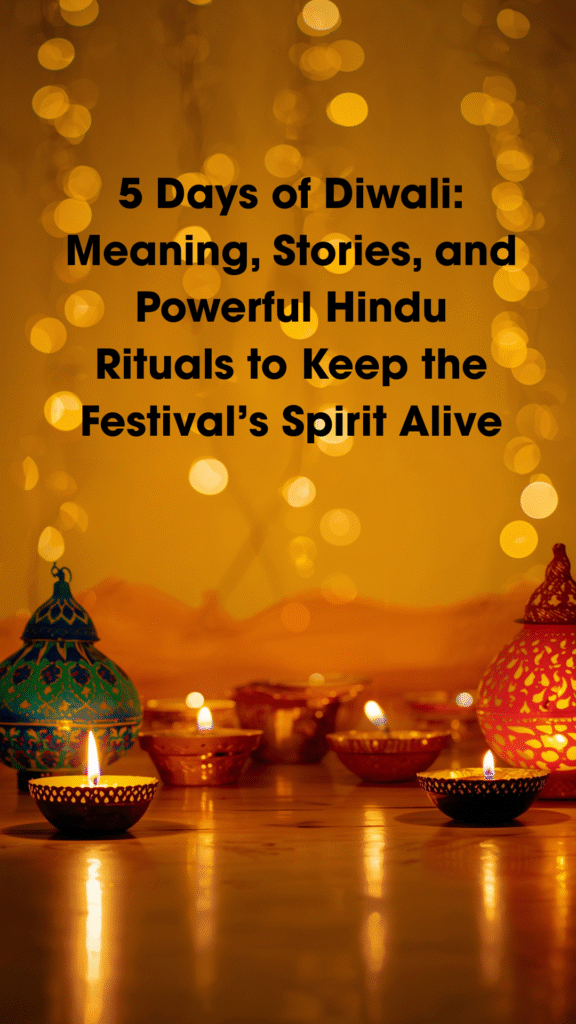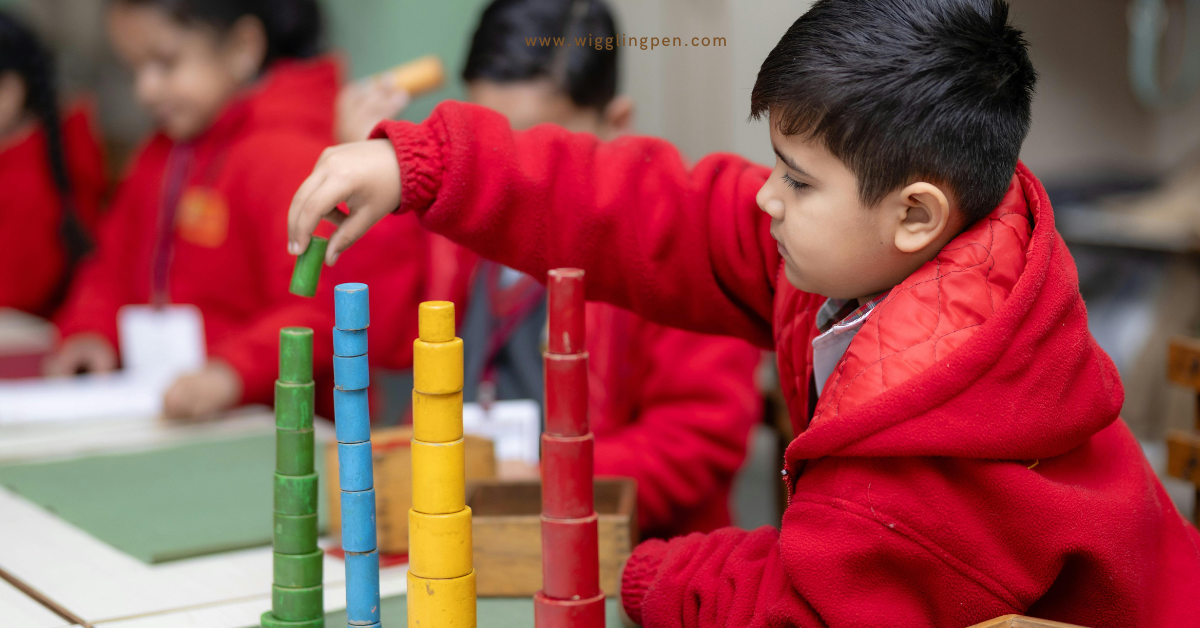
When we think of Diwali, the first image that comes to mind is the soft glow of earthen diyas lined across courtyards, the aroma of freshly made sweets, and families gathering in joy. But Diwali is not just a single day of celebration. It is a five-day festival deeply rooted in Hindu mythology and culture. Each day has its own meaning, its own story, and its own rituals that our ancestors preserved for centuries.
Let’s walk through the five days of Diwali, with their sacred stories, rituals, and mantras, so the younger generation learns not just how to celebrate, but also why.
Day 1: Dhanteras – Inviting Prosperity
Dhanteras, the first day of Diwali, falls on the thirteenth day of Krishna Paksha in the month of Kartik. According to the scriptures, during the Samudra Manthan (churning of the ocean), Lord Dhanvantari emerged carrying a pot of Amrit, the nectar of immortality. This day is also associated with Goddess Lakshmi, the goddess of wealth and prosperity.
Another tale tells of a young prince whose horoscope predicted death by snakebite. His clever wife kept him awake and lit lamps all around. When Yama, the God of Death, arrived, the brightness of the lamps and the glitter of gold and silver blinded him, saving the prince. This legend explains why people light lamps on Dhanteras.
Rituals to Follow
- Clean the Home: Sweep and decorate your house to welcome Goddess Lakshmi.
- Buy Metal or Gold: Buying utensils, silver, or gold is considered auspicious. Even a small diya or spoon is enough to symbolize prosperity.
- Light a Yama Diya: Place a clay lamp outside your home to ward off untimely death.
- Worship Dhanvantari and Lakshmi: Offer flowers, sweets, and light lamps to invite blessings.
Short Mantras
- For Lakshmi: “Om Shreem Hreem Shreem Mahalakshmiyai Namah”
(Chanting this invokes the blessings of wealth and prosperity.) - For Dhanvantari: “Om Namo Bhagavate Vasudevaya Dhanvantaraye Amritakalasha Hastaya Sarvamaya Vinashanaya Trailokya Nathaya Shri Mahavishnave Namah”
(A prayer for good health and protection from ailments.)
Day 2: Naraka Chaturdashi / Choti Diwali – Victory of Good Over Evil
The second day, Naraka Chaturdashi, also known as Choti Diwali, marks the victory of Lord Krishna over the demon king Narakasura. Narakasura had imprisoned thousands of women and terrorized the three worlds. Krishna, with the help of his consort Satyabhama, defeated Narakasura and freed the captives. This day symbolizes the triumph of light over darkness, righteousness over evil.
Rituals to Follow
- Abhyanga Snan: Wake up before sunrise, apply sesame oil and herbal ubtan, and take a sacred bath. This purifies both body and soul.
- Light Diyas: Place lamps around the house to dispel negative energies.
- Offer Prayers to Lord Krishna: Seek protection and guidance.
- Prepare Special Sweets: Laddus, gujiyas, and other traditional treats celebrate joy after victory.
Short Mantra
- “Om Namo Bhagavate Vasudevaya”
(Chant to honor Lord Krishna and remember his victory over evil.)

Day 3: Diwali – The Festival of Lights
Diwali, the third day, is the most celebrated. The legends are many:
- Return of Lord Rama to Ayodhya: After 14 years of exile and defeating Ravana, Lord Rama returned with Sita and Lakshmana. The citizens welcomed them by lighting rows of lamps, symbolizing the victory of dharma.
- Goddess Lakshmi’s Birth: Another belief is that on Diwali night, Goddess Lakshmi descended to bless her devotees with wealth and prosperity.
Rituals to Follow
- Decorate the Home: Rangoli designs, fresh flowers, and lights create an auspicious environment.
- Lakshmi Puja: Place idols or images of Goddess Lakshmi and Lord Ganesha. Offer incense, kumkum, rice, flowers, sweets, and fruits.
- Lighting Diyas: Every corner of the house is illuminated to welcome divine energy.
- Family Gatherings: Share sweets and gifts, and perform small fireworks to celebrate joy and triumph.
Short Mantras
- Lakshmi Gayatri Mantra:
“Om Mahalakshmyai Cha Vidmahe Vishnu Patnyai Cha Dheemahi Tanno Lakshmi Prachodayat”
(Invoke Goddess Lakshmi for guidance and prosperity.) - Ganesh Mantra:
“Om Gan Ganapataye Namah”
(Remove obstacles before starting Lakshmi Puja.)
Day 4: Govardhan Puja / Annakut – Gratitude to Nature
Govardhan Puja, also called Annakut, honors Lord Krishna and nature’s bounty. Long ago, the people of Vrindavan worshipped Lord Indra, but Krishna advised them to honor Govardhan Hill instead. Enraged, Indra sent torrential rains, and Krishna lifted the hill on his finger to protect villagers and cattle.
This day reminds us to respect nature and express gratitude for the resources it provides.
Rituals to Follow
- Make a Govardhan Hill Symbol: Use cow dung, flowers, and decorations to represent Govardhan Hill.
- Prepare Annakut: Offer a variety of vegetarian dishes to Lord Krishna.
- Sing Bhajans: Devotional songs to Krishna fill the air.
- Worship Cows: Considered sacred, cows are adorned and worshipped.
Short Mantra
- “Om Devaya Namah, Om Govardhan Dharaya Vishnave Namah”
(Honor Lord Krishna and his protection over devotees.)
Day 5: Bhai Dooj – Celebrating Sibling Love
Bhai Dooj is dedicated to the sacred bond between brothers and sisters. According to legend, Yamraj, the God of Death, visited his sister Yamuna. She welcomed him with aarti, tilak, and sweets, and he blessed her, declaring that brothers who receive tilak from sisters will have long lives.
Rituals to Follow
- Sisters Perform Aarti and Tilak: Pray for the well-being and long life of brothers.
- Brothers Give Gifts: Symbolizing love and protection.
- Family Gatherings: Enjoy meals together, concluding the five-day festival in joy and harmony.
Short Mantra
- “Yamuna Deviya Sahita Yamrajaya Namah”
(Recited by sisters while applying tilak, invoking blessings for their brothers.)
10 Reasons Why Diwali Rituals Must Be Passed On to the Young Generation
1. To Keep the Spiritual Meaning Alive
Diwali isn’t just about lights or gifts — it’s a reminder of the victory of dharma (righteousness) over adharma (evil).
When children learn why lamps are lit or why we do Lakshmi Puja, they grow up understanding that spirituality isn’t limited to temples — it lives in actions, gratitude, and goodness.
By explaining the meaning behind each ritual, we help them see Diwali as a spiritual awakening, not just a celebration.
2. To Preserve the Connection Between Generations
Every diya we light is a bridge — from grandparents to parents, from parents to children.
When we involve kids in rituals — cleaning the house for Lakshmi, arranging diyas, or singing aarti together — we keep alive the sense of belonging that binds generations.
These shared actions create emotional memories that no gadget or gift can replace.
3. To Teach Values Hidden in Rituals
Each ritual is a lesson wrapped in tradition:
- Dhanteras teaches gratitude for health and wealth.
- Choti Diwali teaches the courage to fight darkness.
- Diwali itself teaches victory of truth.
- Govardhan Puja teaches respect for nature.
- Bhai Dooj teaches love and protection within family.
When children practice these customs, they don’t just perform rituals — they absorb values of discipline, respect, and compassion.
4. To Strengthen Cultural Identity
In a fast-changing world, where festivals are turning into photo opportunities, knowing our rituals gives children a sense of who they are and where they come from.
It connects them to Sanatan Dharma’s timeless wisdom and keeps them grounded in culture even while living in a modern world.
Rituals remind them they belong to a faith that celebrates light, knowledge, and humanity.
5. To Cultivate Gratitude and Mindfulness
When children light a diya, offer sweets, or bow before elders, they learn gratitude in action.
Diwali rituals are designed to slow life down — to clean, decorate, pray, and express thanks for what we already have.
These moments help children appreciate the small blessings — food, family, and peace — before chasing the next thing.
6. To Respect Nature and Simplicity
Govardhan Puja and the lighting of diyas teach that faith and sustainability go hand in hand.
Long before “eco-friendly” became a trend, our rituals already respected nature — using clay lamps, cow dung, and flowers instead of plastic or chemicals.
When children learn this, they grow up understanding that spirituality and environmental care are not separate.
7. To Build Emotional Bond and Family Unity
Rituals bring everyone together — from toddlers helping with rangoli to elders reciting mantras.
These are moments of laughter, love, and learning.
When families sit together for Lakshmi Puja or Bhai Dooj, they create emotional security — children feel part of something larger than themselves.
It teaches them that family is sacred, not just social.
8. To Keep Faith Alive in Everyday Life
Teaching kids to chant a simple mantra like “Om Shreem Hreem Shreem Mahalakshmiyai Namah” is more than devotion — it’s emotional grounding.
It gives them strength during fear, peace in chaos, and hope in struggle.
Passing on these small practices ensures faith becomes a daily habit, not an annual event.
9. To Protect the Essence from Fading
If the meaning behind rituals is lost, Diwali risks becoming just another festival of shopping and sweets.
Our duty is to ensure children know why these rituals exist — so that Diwali continues to symbolize truth, light, and inner awakening.
Every story of Rama, Krishna, or Lakshmi they hear keeps that divine wisdom alive.
10. To Pass On Pride and Purpose
When children understand the beauty of our rituals, they don’t imitate other cultures blindly — they feel proud of their roots.
They grow up carrying the purpose of Diwali in their hearts — to light up not just homes, but minds and souls.
That pride turns into reverence, and reverence into responsibility — to keep these traditions glowing for generations to come.
In Essence
Passing on Diwali rituals isn’t about being old-fashioned — it’s about being rooted. It’s how we preserve our identity, our gratitude, and our light. When the next generation learns to light diyas not just for beauty but for meaning — that’s when Diwali truly. Every diya, every story, every chant strengthens the connection between generations. When children learn these traditions, they are not just celebrating a festival—they are carrying forward a legacy of devotion, discipline, and gratitude.
© Ruchie Verma.
Copyright: Unauthorized use and/or duplication of this material without express and written permission from this site’s author and/or owner is strictly prohibited.






